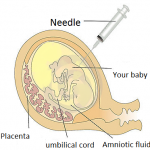A caul is a membrane that may cover a newborn’s head at birth, but it is absolutely nothing to worry about as it is harmless and easily removed by your doctor or midwife. The caul membrane can either be part of the amnion of the amniotic sac or a separate membrane which forms during your […]
amniotic sac

Amniocentesis
Amniocentesis, also known as an Amniotic Fluid Test (AFT), is a diagnostic test usually undertaken between week 15 and week 20 of pregnancy, though it can be taken as early as week 11. It is a test in which about 20 mL of your amniotic fluid, which contains fetal tissues, is used to examine the […]
Amniotic Fluid
Amniotic fluid is the clear, yellowish fluid that surrounds your baby in the amniotic sac. It is mainly made up of water, though from about week 10 of your pregnancy your baby will pass low levels of urine into it. Throughout your pregnancy you carry about 800 mL of amniotic fluid in your womb, but […]
Amniotic sac
The amniotic sac, which some people refer to as “the bag of waters”, is the sac of membranes in your womb in which your baby grows. The amniotic sac is made up of two thin, but strong, transparent membranes: the amnion and the chorion. The amnion is the inner membrane which contains your baby and […]
Placenta
The placenta is a fetomaternal organ that is formed after fertilisation when the zygote implants into the mother’s uterine lining. It has 2 main components: the fetal placenta, which develops from the zygote, and the maternal placenta, which grows from the mother’s uterine tissue. The placenta grows throughout your pregnancy and at 40 weeks will […]

Water birth: a safe alternative?
Water births, or giving birth while you are immersed in a pool of warm water, is a birthing method that has become increasingly more common in the UK over the last two decades. And as usual its rising popularity is accompanied by some controversy in the world of medical professionals. On one hand, water births […]
Identical twins
Identical twins result from a pregnancy in which a single egg divides into two embryos after fertilisation. This means the two babies in your womb share a placenta and an amniotic sac, though some cases of multiple placentas have been reported. The egg usually divides between the first two and eight days after fertilisation, but […]
Fraternal twins
Fraternal twins result from a pregnancy in which two eggs are fertilised during conception. Two eggs means that each baby will have its own placenta and its own amniotic sac. This lowers the risks of the possible complications associated with fetuses who share these two important lifelines during pregnancy. Fraternal twins are the most common […]